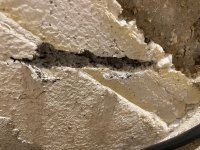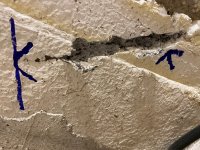six-point socket II
Member
- Joined
- Jun 26, 2016
- Messages
- 2,219
Let's assume the pre owner of your house used an ridiculous amount of concrete nails, set with a powder actuated tool, to fasten a wooden substructure to a concrete ceiling.
This one fooled me, because it came right out when I forced the "two by four" down.
[attachimg=1]
The reality is, with brute force you actually only force the washer and "two by four" over the head of the nail. And sometimes even the washer remains stuck and only the "two by four" gives up eventually.
[attachimg=2]
If said pre owner then also thought it was a great idea to glue styrofoam to an extensive part of the raw ceiling before installing the substructure - albeit not everywhere - you might start to think about alternatives before using an angle grinder with cut-off wheel that will send sparks flying and create a lot of heat.
To better understand the issue why these concrete nails are not easily pried out (especially in comparison to concrete pins used for electrical and other installations), I put on quite a bit of PPE and forced one out. It required an incredible amount of force and was incredibly dangerous, so don't try this at home - chances the nail breaks and shoots through the room are really high!
[attachimg=3]
Now the bended tip of this concrete nail was not caused by my efforts to pry it out, it happened while the concrete nail was set. It hit rebar or gravel inside the concrete. This illustrates why some, that did not bend, came out when demolishing the substructure and others remained in place.
My research showed that currently available concrete nails, offered by specialists in this field like Hilti, are mostly hardened to about 49 hrc per corresponding technical documentation.
So that left open the possibility of using carbide blades on either an oscillating multitool or reciprocating saw. Which can be used for materials/metals with a hardness of up to 50 hrc max. . Now "my" nails are from the late sixties to early seventies, and everyone knows: everything was better back then. So chances are some are hardened to over 50 hrc some might be well below.
So chances are some are hardened to over 50 hrc some might be well below.
[attachimg=4]
My first 4 tries with the oscillating multitool were a classic fail. I didn't even go all the way up to speed 6, but even at my lowest speed test using speed 2 and plenty of movement while cutting I didn't produce less sparks after a couple of seconds of sawing than an angle grinder and cut-off wheel. Additionally the blade lost (actually burned out) a few teeth. (Now it's not that I hadn't seen this happening before on a different application of the same style blade.)
[attachimg=5]
I needed cooling. Now I do have coolant in form of aerosol sprays for drilling and other applications - but overhead that would make a great mess all by itself, add the high speed of oscillating saw blade or reciprocating saw blade - not fun.
I knew there were coolants in form of solid, wax like, sticks but I had never used them before. My friend and dealer gladly sold me one from a reliable lubricant manufacturer and I was able to continue my research on how to remove these hardened concrete nails as easy as possible, without creating a big mess with either the coolant or dust/debris from using the angle grinder with cut-off wheel and of course without overheating/ creating a fire hazard in regards to the overuse of styrofoam on my ceiling.
Additionally I ordered a carbide reciprocating saw blade, especially suited for hardened (50 hrc max.) thick-tough metal, with him.
[attachimg=6]
Details with wax on.
[attachimg=7]
[attachimg=8]
So the coolant did what it was supposed to do, it kept both blades from overheating and also the remains of the concrete nails cooler than before. Especially when the saw blades where given an insignificant amount of time between cuts, it helped to reduce the sparks to an absolute minimum, sometimes even no sparks at all. Re-applying the coolant every few cuts was smooth and easy because of the solid form and easy to handle applicator.
The oscillating carbide saw blade didn't lose any additional teeth, the reciprocating saw blade didn't lose any teeth to begin with.
[attachimg=9]
[attachimg=10]
So I think carbide really makes a difference in applications like this, and greatly expands the use of oscillating multitools and reciprocating saws, but the need for cooling is not stressed enough.
Not only to make these more costly blades (compared to regular bi-metal blades bought by 10/25/50 packs) last longer but also for safety (if need be) and an overall more pleasant/easy cutting experience.
Kind regards,
Oliver
This one fooled me, because it came right out when I forced the "two by four" down.
[attachimg=1]
The reality is, with brute force you actually only force the washer and "two by four" over the head of the nail. And sometimes even the washer remains stuck and only the "two by four" gives up eventually.
[attachimg=2]
If said pre owner then also thought it was a great idea to glue styrofoam to an extensive part of the raw ceiling before installing the substructure - albeit not everywhere - you might start to think about alternatives before using an angle grinder with cut-off wheel that will send sparks flying and create a lot of heat.
To better understand the issue why these concrete nails are not easily pried out (especially in comparison to concrete pins used for electrical and other installations), I put on quite a bit of PPE and forced one out. It required an incredible amount of force and was incredibly dangerous, so don't try this at home - chances the nail breaks and shoots through the room are really high!
[attachimg=3]
Now the bended tip of this concrete nail was not caused by my efforts to pry it out, it happened while the concrete nail was set. It hit rebar or gravel inside the concrete. This illustrates why some, that did not bend, came out when demolishing the substructure and others remained in place.
My research showed that currently available concrete nails, offered by specialists in this field like Hilti, are mostly hardened to about 49 hrc per corresponding technical documentation.
So that left open the possibility of using carbide blades on either an oscillating multitool or reciprocating saw. Which can be used for materials/metals with a hardness of up to 50 hrc max. . Now "my" nails are from the late sixties to early seventies, and everyone knows: everything was better back then.
[attachimg=4]
My first 4 tries with the oscillating multitool were a classic fail. I didn't even go all the way up to speed 6, but even at my lowest speed test using speed 2 and plenty of movement while cutting I didn't produce less sparks after a couple of seconds of sawing than an angle grinder and cut-off wheel. Additionally the blade lost (actually burned out) a few teeth. (Now it's not that I hadn't seen this happening before on a different application of the same style blade.)
[attachimg=5]
I needed cooling. Now I do have coolant in form of aerosol sprays for drilling and other applications - but overhead that would make a great mess all by itself, add the high speed of oscillating saw blade or reciprocating saw blade - not fun.
I knew there were coolants in form of solid, wax like, sticks but I had never used them before. My friend and dealer gladly sold me one from a reliable lubricant manufacturer and I was able to continue my research on how to remove these hardened concrete nails as easy as possible, without creating a big mess with either the coolant or dust/debris from using the angle grinder with cut-off wheel and of course without overheating/ creating a fire hazard in regards to the overuse of styrofoam on my ceiling.
Additionally I ordered a carbide reciprocating saw blade, especially suited for hardened (50 hrc max.) thick-tough metal, with him.
[attachimg=6]
Details with wax on.
[attachimg=7]
[attachimg=8]
So the coolant did what it was supposed to do, it kept both blades from overheating and also the remains of the concrete nails cooler than before. Especially when the saw blades where given an insignificant amount of time between cuts, it helped to reduce the sparks to an absolute minimum, sometimes even no sparks at all. Re-applying the coolant every few cuts was smooth and easy because of the solid form and easy to handle applicator.
The oscillating carbide saw blade didn't lose any additional teeth, the reciprocating saw blade didn't lose any teeth to begin with.
[attachimg=9]
[attachimg=10]
So I think carbide really makes a difference in applications like this, and greatly expands the use of oscillating multitools and reciprocating saws, but the need for cooling is not stressed enough.
Not only to make these more costly blades (compared to regular bi-metal blades bought by 10/25/50 packs) last longer but also for safety (if need be) and an overall more pleasant/easy cutting experience.
Kind regards,
Oliver
Attachments
-
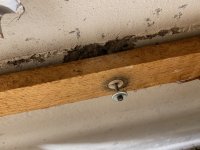 IMG_4250.jpeg263.4 KB · Views: 627
IMG_4250.jpeg263.4 KB · Views: 627 -
 IMG_4899.jpeg353.1 KB · Views: 571
IMG_4899.jpeg353.1 KB · Views: 571 -
 IMG_4896.jpeg274.7 KB · Views: 567
IMG_4896.jpeg274.7 KB · Views: 567 -
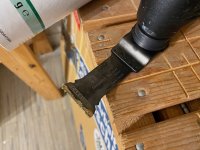 IMG_4890.jpeg241.3 KB · Views: 568
IMG_4890.jpeg241.3 KB · Views: 568 -
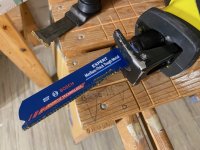 IMG_4889.jpeg244.9 KB · Views: 571
IMG_4889.jpeg244.9 KB · Views: 571 -
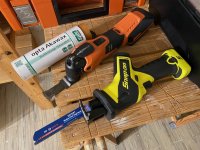 IMG_4888.jpeg297 KB · Views: 567
IMG_4888.jpeg297 KB · Views: 567 -
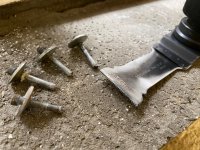 IMG_4803.jpeg311.5 KB · Views: 584
IMG_4803.jpeg311.5 KB · Views: 584 -
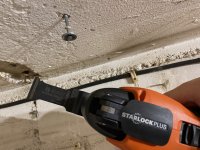 IMG_4793.jpeg289.2 KB · Views: 580
IMG_4793.jpeg289.2 KB · Views: 580 -
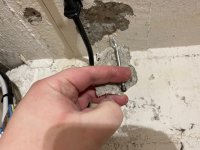 IMG_5814.jpeg170.6 KB · Views: 606
IMG_5814.jpeg170.6 KB · Views: 606 -
 IMG_4793 (1).jpeg289.5 KB · Views: 614
IMG_4793 (1).jpeg289.5 KB · Views: 614


